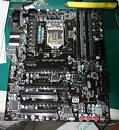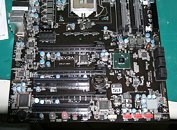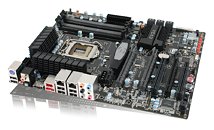- Joined
- Oct 9, 2007
- Messages
- 47,525 (7.48/day)
- Location
- Hyderabad, India
| System Name | RBMK-1000 |
|---|---|
| Processor | AMD Ryzen 7 5700G |
| Motherboard | ASUS ROG Strix B450-E Gaming |
| Cooling | DeepCool Gammax L240 V2 |
| Memory | 2x 8GB G.Skill Sniper X |
| Video Card(s) | Palit GeForce RTX 2080 SUPER GameRock |
| Storage | Western Digital Black NVMe 512GB |
| Display(s) | BenQ 1440p 60 Hz 27-inch |
| Case | Corsair Carbide 100R |
| Audio Device(s) | ASUS SupremeFX S1220A |
| Power Supply | Cooler Master MWE Gold 650W |
| Mouse | ASUS ROG Strix Impact |
| Keyboard | Gamdias Hermes E2 |
| Software | Windows 11 Pro |
EVGA seems to have found its roots in Intel's 5-series chipset due to lack of chipsets from NVIDIA that support the latest Intel processors. In the process, EVGA gets to make Intel 5-series motherboards brandishing SLI support, as well as some pretty impressive enthusiast-grade features. With the X58 Classified series, EVGA took on the mighty ASUS to give out a full-featured motherboard for overclocking LGA-1366 processors. It looks like the company is working on another motherboard with similar credentials for LGA-1156 socket processors, based on the Intel P55/P57 chipset.
The EVGA 132-LF-E657 is a full-featured LGA-1156 motherboard focussed on overclocking. The CPU is powered by a lavish 12-phase circuit that makes use of DrMOS (driver-MOSFETs). The CPU socket further seats LICC (Low Inductance Ceramic Capacitors). Electrical stability is brought about by two 8-pin ATX CPU power connectors, a design first featured on the X58 Classified. Additional power stability for the expansion slots is brought about by a 4-pin Molex input. The four DDR3 DIMM slots are powered by a 3-phase circuit. Intel Braidwood technology is supported on this motherboard. The technology involves an NVRAM module that speeds up OS and applications loading. There are two clock generators on this board, perhaps to handle two independent clock domains that gives the user greater control over a few settings.

The expansion on this board is care of three PCI-E 2.0 x16 slots. Two of these are routed to the processor northbridge, and work electrically x8, x8, when both are populated. A third one is connected to the P55/P57 PCH, which is electrically x4. Other slots include one PCI-E x1, and two legacy PCI slots. The board further features PCI-E slot disable jumpers that cut off power to specific slots, turning off the associated voltage regulators.

Apart from a plethora of enthusiast-friendly settings one might be able to find in the system BIOS setup utility, greater control is offered by EVGA ECP module that extends core motherboard controls on a PCB over a ribbon cable, including the PCI-E disable jumpers. Another feature is the redundant BIOS that stores three physical copies of the BIOS on separate EEPROM chips. EVGA may also include a motherboard control gadget that has a screen, a few control buttons, and lets users tune low-level overclocking settings on the fly. Not much is known about this gadget. On the peripheral connectivity front, the P55 PCH provides six SATA II ports, while an additional controller drives eSATA ports. 8-channel audio with digital IO, two gigabit Ethernet controllers, FireWire, and a number of USB ports make for the rest of it. The board may feature in the first wave of motherboard launches following the introduction of the processor platform.



View at TechPowerUp Main Site
The EVGA 132-LF-E657 is a full-featured LGA-1156 motherboard focussed on overclocking. The CPU is powered by a lavish 12-phase circuit that makes use of DrMOS (driver-MOSFETs). The CPU socket further seats LICC (Low Inductance Ceramic Capacitors). Electrical stability is brought about by two 8-pin ATX CPU power connectors, a design first featured on the X58 Classified. Additional power stability for the expansion slots is brought about by a 4-pin Molex input. The four DDR3 DIMM slots are powered by a 3-phase circuit. Intel Braidwood technology is supported on this motherboard. The technology involves an NVRAM module that speeds up OS and applications loading. There are two clock generators on this board, perhaps to handle two independent clock domains that gives the user greater control over a few settings.

The expansion on this board is care of three PCI-E 2.0 x16 slots. Two of these are routed to the processor northbridge, and work electrically x8, x8, when both are populated. A third one is connected to the P55/P57 PCH, which is electrically x4. Other slots include one PCI-E x1, and two legacy PCI slots. The board further features PCI-E slot disable jumpers that cut off power to specific slots, turning off the associated voltage regulators.

Apart from a plethora of enthusiast-friendly settings one might be able to find in the system BIOS setup utility, greater control is offered by EVGA ECP module that extends core motherboard controls on a PCB over a ribbon cable, including the PCI-E disable jumpers. Another feature is the redundant BIOS that stores three physical copies of the BIOS on separate EEPROM chips. EVGA may also include a motherboard control gadget that has a screen, a few control buttons, and lets users tune low-level overclocking settings on the fly. Not much is known about this gadget. On the peripheral connectivity front, the P55 PCH provides six SATA II ports, while an additional controller drives eSATA ports. 8-channel audio with digital IO, two gigabit Ethernet controllers, FireWire, and a number of USB ports make for the rest of it. The board may feature in the first wave of motherboard launches following the introduction of the processor platform.



View at TechPowerUp Main Site
Last edited:










 . Socket wise LGA 1156 is mainstream(i5/lower end i7's), LGA 1155 is supposed to be for i3 "i thk" but could be wrong.
. Socket wise LGA 1156 is mainstream(i5/lower end i7's), LGA 1155 is supposed to be for i3 "i thk" but could be wrong.